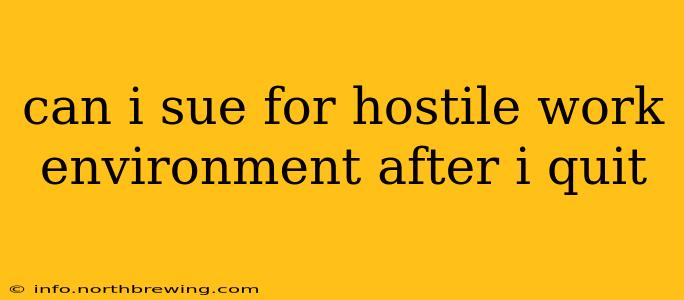Can I Sue for Hostile Work Environment After I Quit?
Yes, you can generally sue for a hostile work environment after you quit your job. However, there are important factors and deadlines to consider. This isn't a simple yes or no answer, and the success of your case will depend on several key elements. Let's explore the specifics.
What Constitutes a Hostile Work Environment?
A hostile work environment is a workplace where harassment based on protected characteristics (race, religion, sex, national origin, age, disability, etc.) is so frequent or severe that it creates a discriminatory abusive atmosphere. This doesn't require a single, shocking event; it can be a pattern of smaller, less obvious incidents that cumulatively create an unbearable work situation. Examples include:
- Verbal harassment: Offensive jokes, slurs, threats, or constant belittling.
- Physical harassment: Unwanted touching, assault, or intimidation.
- Visual harassment: Offensive posters, cartoons, or emails.
- Non-verbal harassment: Exclusion from meetings, opportunities, or social events.
The harassment must be severe or pervasive enough to alter the conditions of your employment and create an abusive working environment. A few isolated incidents are usually not enough to establish a hostile work environment claim.
Why You Might Still Sue After Quitting
Even though you've left the job, you might still have grounds to sue because:
- The harassment forced you to quit: If the hostile work environment became so unbearable that a reasonable person would have felt compelled to resign, you may have a constructive dismissal claim. This means you were essentially forced out, even though you weren't formally fired.
- You suffered damages: The harassment might have caused you emotional distress, financial losses (loss of income, medical bills), or other harms. These damages can be compensated through a lawsuit.
- Legal deadlines: You usually have a limited time (the statute of limitations varies by state and the specific claim) to file a lawsuit. This period starts running from the last incident of harassment, not necessarily the date you quit.
What You Need to Prove
To win a hostile work environment lawsuit, you generally need to prove:
- The harassment was unwelcome: You did not solicit or encourage the behavior.
- The harassment was based on a protected characteristic: The harassment was targeted at you because of your race, religion, sex, etc.
- The harassment was severe or pervasive enough to create a hostile work environment: The conduct was more than just offensive; it was objectively abusive and created a hostile environment.
- The employer knew or should have known about the harassment and failed to take reasonable steps to stop it: This is crucial. If the employer was aware of the harassment but did nothing, they are likely liable.
What Happens After You Quit?
After quitting, it's vital to:
- Document everything: Gather evidence such as emails, texts, witness statements, and any records of complaints you filed with your employer.
- Seek legal advice immediately: An experienced employment lawyer can advise you on your rights and options, and help determine if you have a viable case.
- File a charge with the Equal Employment Opportunity Commission (EEOC) or your state's equivalent: This is often a necessary step before filing a lawsuit, although there are exceptions.
How Long Do I Have to File a Lawsuit?
Statutes of limitations for employment discrimination vary by state and the type of claim. It's crucial to consult an attorney in your jurisdiction to determine the applicable deadline. Missing this deadline can bar your ability to pursue legal action.
This information is for general guidance only and does not constitute legal advice. You should consult with an employment attorney to discuss the specifics of your situation and determine the best course of action.
